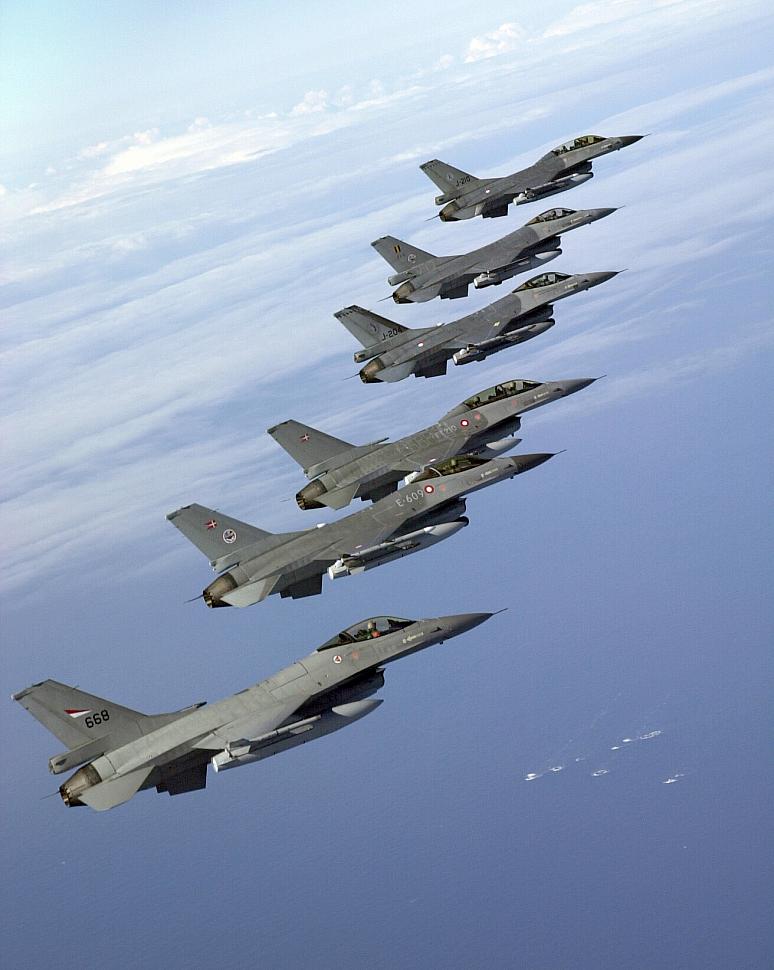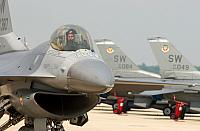Fighter Jet News
F-16 Fighting Falcon News
USAF and European Air Forces adding new capabilities to their F-16s
January 7, 2005 (by
Lieven Dewitte) -
The U.S. Air Force and five EPAF countries - Belgium, Denmark, the Netherlands, Norway and Portugal - are receiving new technologies for their F-16s that will ensure the latest combat capabilities, along with an unprecedented degree of interoperability and cost savings among these NATO allies.

The capabilities are being implemented mostly through software developed by Lockheed Martin.
The new software packages for the USAF F-16s, designated M3+, and the corresponding EPAF (European Participating Air Forces) version, designated M3, were released this summer and are being implemented on aircraft having received appropriate avionics upgrades (described in text below). There is a high degree of commonality in the software, with some differences owing to features that are unique to the various aircraft models.
The most notable common new capabilities are the Link 16 data link and a helmet-mounted cueing system (HMCS). The USAF F-16s also will be receiving a capability to deliver the Lockheed Martin AGM-158 Joint Air-to-Surface Standoff Missile (JASSM) and have compatibility with the Lockheed Martin Sniper XR targeting pod, both recently certified on the F-16. The European F-16s will gain the capability to deliver the Joint Direct Attack Munition (JDAM).
"This M3/M3+ software release is an important event for both the USAF and EPAF operators," said Col. Scott W. Jansson, F-16 Systems Group commander at Wright-Patterson Air Force Base, Ohio. "Not only will they receive the latest enhanced capabilities, the common systems path they are following is providing significant cost savings in development, fielding and support."
The M3+ software is being installed on the 200-plus USAF block 50 F-16C/Ds that are receiving the F-16 Common Configuration Implementation Program (CCIP) modification, which is providing a common hardware upgrade to the cockpit and avionics of these and approximately 400 block 40 F-16C/Ds. This M3+ software update is being installed as a field retrofit to Block 50 aircraft already modified with CCIP hardware, and the rest of the aircraft will receive the software loads during the initial depot modification at the Ogden Air Logistics Center, Utah. Modification of the Block 40 aircraft will begin in 2006.
The M3 software will be installed on approximately 350 EPAF F-16A/Bs that have already undergone the F-16A/B Mid-Life Update modification and are now receiving hardware changes associated with the M3 upgrade. The M3 modification will take place at depot facilities in each country.
"The USAF/EPAF joint software development program has been a great success," said June Shrewsbury, vice president, F-16 programs. "The M3/M3+ update has been on schedule since it was initiated in March 2000. We are currently in work on M4/M4+ to be released in 2007 and M5/M5+ to be released in 2009. This commonality ensures a high degree of interoperability among these NATO allies. It also means these capabilities are available for other F-16 customers."
The Link 16 Multifunctional Information Distribution System (MIDS) provides a secure, jam resistant, high-capacity data communications link with other fighters, airborne control aircraft and ground control centers. The NATO-standard Link 16 ensures a high degree of interoperability between the USAF and allied air forces, increased battlefield control, and excellent situational awareness for the pilots. Link 16 ensures that F-16s will be at the leading edge of network-centric warfare initiatives and that they will interface well with next-generation combat aircraft, such as the F/A-22 and F-35 Joint Strike Fighter.
The helmet-mounted cueing system allows various weapons and sensors to be cued to the pilot's line of sight, and the pilot's eyes to be cued to targets that sensors are tracking, or targets data-linked from other sources. The system is particularly useful in cueing and launching agile weapons, such as AIM-9X, at high angles off the aircraft's nose.
The value of these enhancements was made evident during separate initial operational test and evaluation activities performed in the United States and in Norway earlier this year.
Related article:

A Norwegian & Belgian, together with 2 Dutch and as much Danish vipers are flying over the North Sea. Note that all these airframes have undergone the extensive MLU upgrade program. Currently these airframes are receiving the M3 software upgrade. [LMTAS photo
]
The new software packages for the USAF F-16s, designated M3+, and the corresponding EPAF (European Participating Air Forces) version, designated M3, were released this summer and are being implemented on aircraft having received appropriate avionics upgrades (described in text below). There is a high degree of commonality in the software, with some differences owing to features that are unique to the various aircraft models.
The most notable common new capabilities are the Link 16 data link and a helmet-mounted cueing system (HMCS). The USAF F-16s also will be receiving a capability to deliver the Lockheed Martin AGM-158 Joint Air-to-Surface Standoff Missile (JASSM) and have compatibility with the Lockheed Martin Sniper XR targeting pod, both recently certified on the F-16. The European F-16s will gain the capability to deliver the Joint Direct Attack Munition (JDAM).
"This M3/M3+ software release is an important event for both the USAF and EPAF operators," said Col. Scott W. Jansson, F-16 Systems Group commander at Wright-Patterson Air Force Base, Ohio. "Not only will they receive the latest enhanced capabilities, the common systems path they are following is providing significant cost savings in development, fielding and support."
The M3+ software is being installed on the 200-plus USAF block 50 F-16C/Ds that are receiving the F-16 Common Configuration Implementation Program (CCIP) modification, which is providing a common hardware upgrade to the cockpit and avionics of these and approximately 400 block 40 F-16C/Ds. This M3+ software update is being installed as a field retrofit to Block 50 aircraft already modified with CCIP hardware, and the rest of the aircraft will receive the software loads during the initial depot modification at the Ogden Air Logistics Center, Utah. Modification of the Block 40 aircraft will begin in 2006.
The M3 software will be installed on approximately 350 EPAF F-16A/Bs that have already undergone the F-16A/B Mid-Life Update modification and are now receiving hardware changes associated with the M3 upgrade. The M3 modification will take place at depot facilities in each country.
"The USAF/EPAF joint software development program has been a great success," said June Shrewsbury, vice president, F-16 programs. "The M3/M3+ update has been on schedule since it was initiated in March 2000. We are currently in work on M4/M4+ to be released in 2007 and M5/M5+ to be released in 2009. This commonality ensures a high degree of interoperability among these NATO allies. It also means these capabilities are available for other F-16 customers."
The Link 16 Multifunctional Information Distribution System (MIDS) provides a secure, jam resistant, high-capacity data communications link with other fighters, airborne control aircraft and ground control centers. The NATO-standard Link 16 ensures a high degree of interoperability between the USAF and allied air forces, increased battlefield control, and excellent situational awareness for the pilots. Link 16 ensures that F-16s will be at the leading edge of network-centric warfare initiatives and that they will interface well with next-generation combat aircraft, such as the F/A-22 and F-35 Joint Strike Fighter.
The helmet-mounted cueing system allows various weapons and sensors to be cued to the pilot's line of sight, and the pilot's eyes to be cued to targets that sensors are tracking, or targets data-linked from other sources. The system is particularly useful in cueing and launching agile weapons, such as AIM-9X, at high angles off the aircraft's nose.
The value of these enhancements was made evident during separate initial operational test and evaluation activities performed in the United States and in Norway earlier this year.
Related article:
- LMTAS receives contract for major software upgrade to U.S. and European F-16s - Sunday, January 24, 1999
Additional images:


A Shaw AFB F-16 block 50 who already received the CCIP upgrade is taxiing to start a new training mission. The block 50 CCIP airframes are currently being retrofitted with the M3+ software upgrade. [LMTAS photo
]
Related articles:
Tags
Tags
